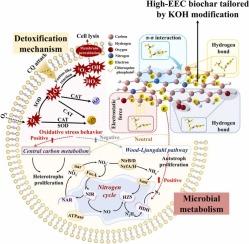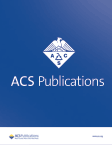KOH-modified biochar enhances nitrogen metabolism of the chloroquine phosphate-disturbed anammox: physical binding, EPS modulation and versatile metabolic hierarchy
IF 2.9
Q2 PUBLIC, ENVIRONMENTAL & OCCUPATIONAL HEALTH
引用次数: 0
Abstract
Chloroquine phosphate (CQ) poses strong biotoxicity on anammox process, and thus detoxifying is essential for the stable operation of anammox in treating CQ-bearing wastewater. Biochar has been proven to simultaneously detoxify pollutant and modulate nitrogen cycle in anammox by its shelter effect and electron exchange capacity (EEC) ability. To further improve the ability of biochar to promote the nitrogen metabolism of anammox, a KOH modification strategy was used to tailor a high-EEC biochar in this work. KOH modified biochar can bind CQ for detoxification driven by hydrogen bond, π–π interaction, and electrostatic interaction. Meanwhile, the EEC of modified biochar increased by 70% than that of pristine biochar, thus improving nitrogen removal efficiency by 55.6% and 9.5% than CQ and BC group, respectively. Besides, the microorganism regulated by modified biochar produced more α-helix configuration, improving EPS barrier ability to CQ and sludge granulation. Lastly, metagenomic analysis revealed that modified biochar can stimulate the Wood-Ljungdahl pathway, increased the relative abundance of CODH from 0.74% in CQ to 1.00% in modified BC group. It favored the proliferation of autotrophic microorganisms, especially increased the relative abundance of anammox bacteria by 86.8% than CQ group. This work will shed the light on integrating high-EEC biochar into anammox to cope with the micropollutants stress.

KOH 改性生物炭能增强氯喹磷酸盐扰动厌氧菌的氮代谢:物理结合、EPS 调节和多功能代谢层次结构
磷酸氯喹(CQ)对anammox过程具有很强的生物毒性,因此在处理含CQ废水时,解毒对anammox的稳定运行至关重要。生物炭的庇护效应和电子交换容量(EEC)能力已被证明可同时解毒污染物和调节厌氧池中的氮循环。为了进一步提高生物炭促进 Anammox 氮代谢的能力,本研究采用 KOH 改性策略来定制高 EEC 生物炭。经 KOH 改性的生物炭可通过氢键、π-π 相互作用和静电作用结合 CQ 进行解毒。同时,改性生物炭的 EEC 比原始生物炭提高了 70%,因此脱氮效率比 CQ 组和 BC 组分别提高了 55.6% 和 9.5%。此外,改性生物炭调节的微生物产生了更多的α-螺旋构型,提高了 EPS 对 CQ 和污泥颗粒化的阻隔能力。最后,元基因组分析表明,改性生物炭能刺激伍德-荣格达尔途径,使 CODH 的相对丰度从 CQ 组的 0.74% 提高到改性 BC 组的 1.00%。它有利于自养微生物的增殖,尤其是使厌氧菌的相对丰度比 CQ 组提高了 86.8%。这项工作将揭示如何将高 EEC 生物炭融入厌氧反应,以应对微污染物的压力。
本文章由计算机程序翻译,如有差异,请以英文原文为准。
求助全文
约1分钟内获得全文
求助全文
来源期刊

ACS Chemical Health & Safety
PUBLIC, ENVIRONMENTAL & OCCUPATIONAL HEALTH-
CiteScore
3.10
自引率
20.00%
发文量
63
期刊介绍:
The Journal of Chemical Health and Safety focuses on news, information, and ideas relating to issues and advances in chemical health and safety. The Journal of Chemical Health and Safety covers up-to-the minute, in-depth views of safety issues ranging from OSHA and EPA regulations to the safe handling of hazardous waste, from the latest innovations in effective chemical hygiene practices to the courts'' most recent rulings on safety-related lawsuits. The Journal of Chemical Health and Safety presents real-world information that health, safety and environmental professionals and others responsible for the safety of their workplaces can put to use right away, identifying potential and developing safety concerns before they do real harm.
 求助内容:
求助内容: 应助结果提醒方式:
应助结果提醒方式:


